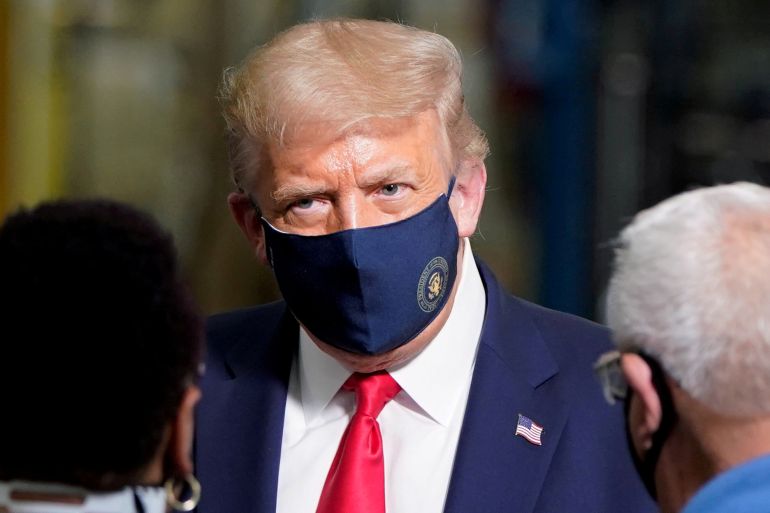Stocks, oil prices extend losses after Trump says has coronavirus
Trump’s health status could result in greater volatility in financial markets as US election nears, analysts say.

United States stock futures extended losses on Friday after President Donald Trump said he and his wife have tested positive for the coronavirus, weeks ahead of elections.
Futures for the S&P 500 slid 1.21 percent by early afternoon in Asia, while US Treasury yields also fell as bond prices rose.
Keep reading
list of 4 itemsAs US inflation ticks back up, it could impact the presidential election
Will the US unemployment rate continue at historic lows?
The UK’s new minimum wage ‘badly needed’ but many calling for more
The US dollar was also higher, particularly against the British pound, the Australian and New Zealand dollars as investors sought what they consider relatively safe assets.
Trump said on Twitter that he and his wife had been tested for coronavirus after Hope Hicks, a senior adviser who recently travelled with the president, tested positive.
He later tweeted that he and the first lady had tested positive: “We will begin our quarantine and recovery process immediately,” he said.
Trump’s positive coronavirus test result could cause a new wave of market volatility as investors brace for the hotly contested presidential election in November.
“It has the potential to reduce Trump’s campaigning ability. He’s got a lot on and it’s an interruption,” said Sean Callow, currency strategist at Westpac in Sydney.
“It also hurts him as far as the whole narrative that it’s really not much to worry about – it puts the COVID crisis itself back front and centre.”
![US equity futures price chart [Bloomberg]](/wp-content/uploads/2020/10/365043483.jpg?w=770&resize=770%2C433)
MSCI’s broadest index of Asia-Pacific shares outside Japan was down 0.27 percent. Australia’s S&P/ASX 200 index fell 0.98 percent as a decline in oil and copper prices weighed on the country’s resources sector.
Japan’s Nikkei 225 index erased gains and fell 0.69 percent as the Tokyo Stock Exchange resumed normal trading after its worst-ever outage brought the world’s third-largest equity market to a standstill.
Euro Stoxx 50 futures were up 0.06 percent, German DAX futures rose 0.03 percent, but FTSE futures were down by 1.02 percent.
Markets had been choppy early on Friday after a spate of data, including jobless claims and consumer spending, suggested that the plodding US economic recovery could be losing steam.
Futures for the tech-heavy Nasdaq fell 1.7 percent. The benchmark 10-year Treasury yield fell to 0.6545 percent.
China’s stock and bond markets, foreign exchange and commodity futures markets are closed from October 1-8 for the Golden Week holiday. South Korean and Hong Kong markets are also closed on Friday for holidays.
US markets kicked off the fourth quarter by closing higher on Thursday while investors tracked progress in negotiations for additional fiscal stimulus.
The Dow Jones Industrial Average rose 0.13 percent on Thursday. The S&P 500 gained 0.53 percent and the Nasdaq Composite added 1.42 percent.
Global equities have struggled lately following a sharp rebound from a plunge in March that reached a peak in September.
Thousands of job cuts this week showed how firms are still wrestling with readjustments needed to survive in the pandemic era as virus cases continue to climb.
“The risks to the rally are real,” Joanne Feeney, partner at Advisors Capital Management LLC, said on Bloomberg TV. “What’s very unusual is that there is a lot more near-term risk at the moment than longer term.”
More US jobs data
US consumer spending is starting to slow due to the shaky jobs market. If policymakers cannot agree on more support, the US economy could lose more momentum.
Traders are also waiting for the Labor Department’s report on non-farm payrolls and the jobless rate later Friday, following new layoff announcements from the likes of Disney and Goldman Sachs.
The dollar index jumped 0.3 percent on risk aversion.
The spot gold price fell 0.55 percent to $1,894.60 an ounce, adding to its worst month since November 2016, while oil prices continued to fall, adding to a 10-percent September drop.
Brent crude futures were trading down 0.93 percent at $40.54 per barrel on Friday, while US crude futures were down 0.98 percent at $38.34 per barrel.
Oil prices fell more than 3 percent on Thursday as rising coronavirus cases around the world dampened the demand outlook, while a rise last month in output from members of the Organization of the Petroleum Exporting Countries also pressured prices.
